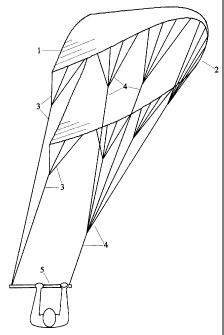Some of the information on this Web page has been provided by external sources. The Government of Canada is not responsible for the accuracy, reliability or currency of the information supplied by external sources. Users wishing to rely upon this information should consult directly with the source of the information. Content provided by external sources is not subject to official languages, privacy and accessibility requirements.
Any discrepancies in the text and image of the Claims and Abstract are due to differing posting times. Text of the Claims and Abstract are posted:
| (12) Patent: | (11) CA 2297643 |
|---|---|
| (54) English Title: | FLEXIBLE KITE |
| (54) French Title: | CERF-VOLANT FLEXIBLE |
| Status: | Expired |
| (51) International Patent Classification (IPC): |
|
|---|---|
| (72) Inventors : |
|
| (73) Owners : |
|
| (71) Applicants : |
|
| (74) Agent: | BROUILLETTE LEGAL INC. |
| (74) Associate agent: | |
| (45) Issued: | 2004-12-21 |
| Reissued: | 2011-04-12 |
| (22) Filed Date: | 2000-01-31 |
| (41) Open to Public Inspection: | 2001-07-31 |
| Examination requested: | 2003-03-17 |
| Availability of licence: | N/A |
| (25) Language of filing: | English |
| Patent Cooperation Treaty (PCT): | No |
|---|
| (30) Application Priority Data: | None |
|---|
A spoon like simple skin kite for kite sailing having a long flexible rod or tube on the leading edge as the only structure, many bridles that are all connected directly to that rod, no lines, an elongated straight handle to steer it that turns around the same axis as the kite turns.
Un cerf-volant à simple voile en forme de cuillère pour une application de vol aérotracté ayant une tige ou un tube long et flexible sur le bord d'attaque pour seule structure, de nombreuses drisses qui sont toutes reliées directement à cette tige, aucune ligne, une poignée de direction droite et allongée qui tourne autour du même axe que le cerf-volant.
Note: Claims are shown in the official language in which they were submitted.
Note: Descriptions are shown in the official language in which they were submitted.

For a clearer understanding of the status of the application/patent presented on this page, the site Disclaimer , as well as the definitions for Patent , Administrative Status , Maintenance Fee and Payment History should be consulted.
| Title | Date |
|---|---|
| Forecasted Issue Date | 2004-12-21 |
| (22) Filed | 2000-01-31 |
| (41) Open to Public Inspection | 2001-07-31 |
| Examination Requested | 2003-03-17 |
| (45) Issued | 2004-12-21 |
| Reissued | 2011-04-12 |
| Expired | 2020-01-31 |
There is no abandonment history.
| Fee Type | Anniversary Year | Due Date | Amount Paid | Paid Date |
|---|---|---|---|---|
| Application Fee | $150.00 | 2000-01-31 | ||
| Maintenance Fee - Application - New Act | 2 | 2002-01-31 | $50.00 | 2001-11-22 |
| Maintenance Fee - Application - New Act | 3 | 2003-01-31 | $50.00 | 2002-12-17 |
| Request for Examination | $200.00 | 2003-03-17 | ||
| Maintenance Fee - Application - New Act | 4 | 2004-02-02 | $50.00 | 2003-11-20 |
| Final Fee | $150.00 | 2004-10-12 | ||
| Maintenance Fee - Patent - New Act | 5 | 2005-01-31 | $100.00 | 2005-04-04 |
| Expired 2019 - Late payment fee under ss.3.1(1) | 2005-05-08 | $50.00 | 2005-04-04 | |
| Maintenance Fee - Patent - New Act | 6 | 2006-01-31 | $100.00 | 2005-11-18 |
| Maintenance Fee - Patent - New Act | 7 | 2007-01-31 | $100.00 | 2006-12-11 |
| Registration of a document - section 124 | $100.00 | 2007-04-17 | ||
| Reissue a patent | $1,600.00 | 2007-05-17 | ||
| Maintenance Fee - Patent - New Act | 8 | 2008-01-31 | $100.00 | 2007-11-09 |
| Maintenance Fee - Patent - New Act | 9 | 2009-02-02 | $400.00 | 2009-02-10 |
| Maintenance Fee - Patent - New Act | 10 | 2010-02-01 | $325.00 | 2010-03-22 |
| Maintenance Fee - Patent - New Act | 11 | 2011-01-31 | $325.00 | 2011-03-23 |
| Maintenance Fee - Patent - New Act | 12 | 2012-01-31 | $125.00 | 2012-01-19 |
| Maintenance Fee - Patent - New Act | 13 | 2013-01-31 | $125.00 | 2013-01-22 |
| Maintenance Fee - Patent - New Act | 14 | 2014-01-31 | $125.00 | 2014-01-13 |
| Maintenance Fee - Patent - New Act | 15 | 2015-02-02 | $225.00 | 2015-01-20 |
| Maintenance Fee - Patent - New Act | 16 | 2016-02-01 | $225.00 | 2016-01-18 |
| Maintenance Fee - Patent - New Act | 17 | 2017-01-31 | $225.00 | 2017-01-26 |
| Maintenance Fee - Patent - New Act | 18 | 2018-01-31 | $225.00 | 2017-12-21 |
| Maintenance Fee - Patent - New Act | 19 | 2019-01-31 | $225.00 | 2018-12-20 |
Note: Records showing the ownership history in alphabetical order.
| Current Owners on Record |
|---|
| GODBOUT, LUC |
| Past Owners on Record |
|---|
| POTVIN, RAYMOND |